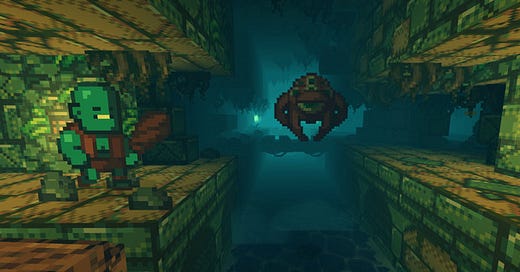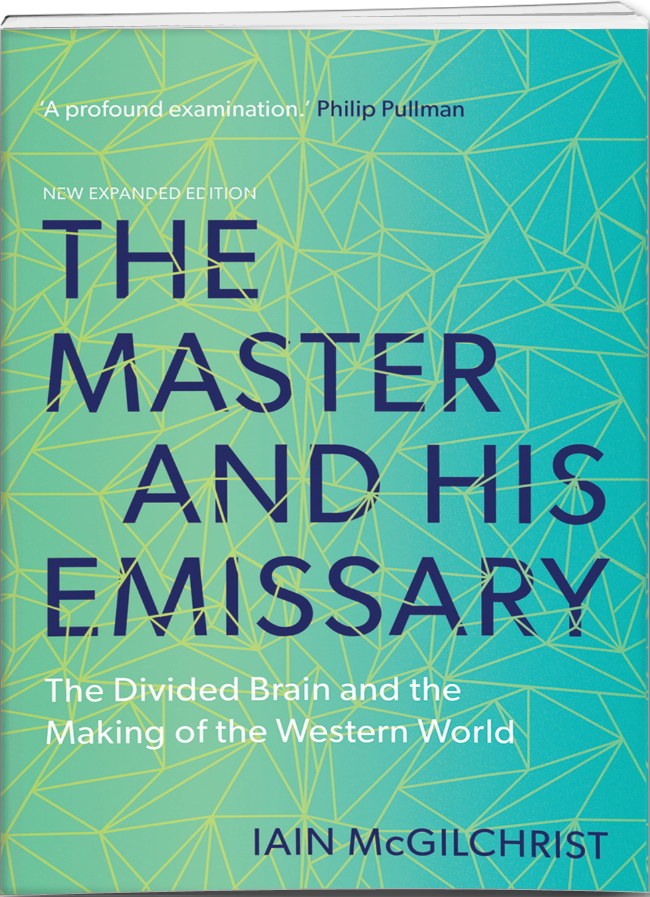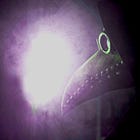Beginning in Bits and Bytes
Growing up, I enjoyed videogames a lot. Not the likes of the latest shooters or graphical masterpieces, but of classic and retro videogames. I always found pixel and low-poly art to have a certain charm, while the simplicity of the ideas and mechanics seemed wonderful in creating raw and engaging entertainment experiences. I enjoyed it when new games took inspiration from the limitations of these titles but combined them with the wisdom of game design lessons compiled from a few decades of experimentation. Delver is a great example if this - taking the fast-paced nature of games like Quake with the dungeon crawling nature of Rogue, all tied up with fantasy pixel art and a blocky aesthetic.
Then, I discovered something even more interesting - that people were still creating their own games for old consoles that had long been discontinued from production. An example that really caught my interest was the work of Morphcat Games and, in particular, their game “Micro Mages”, which was made for the NES with the same constraints as the original Super Mario Brothers. They did a great mini-documentary on their process, and why they were attracted to creating a game that could fit within the limitations of the original Nintendo Entertainment System.
So why am I - someone who works primarily in poetry - talking about niche videogames?
For me, all of these games do an excellent job at embodying the principle of creative constraint - the idea that, by putting certain restrictions around how we create a piece of art or entertainment, we inspire ourselves to maximise what we are able to accomplish within those constraints and create something incredible. It is perhaps the opposite of thinking “outside the box” - instead of running from obstacles, we embrace them.
I suspect that part of what drew me to those videogames in the first place is in their embrace of creative constraint - an idea that I find particularly attractive and, in some ways, fundamental to life. I want to use this piece to explore the implications of creative constraints in poetic form and the way in which I utilise form in my writing to accentuate various qualities in a way I might not be able to otherwise.
Do We Really Have Free Will?
I feel I can’t tackle this topic to enough depth without first touching on how we make decisions and, by extension, consciousness. It was Master and His Emissary by Dr Iain McGilchrist - ironically, a book that specifically declares it is not interested in answering questions about consciousness - that really got me thinking seriously about these questions. Something within the book that particularly struck me was of the right hemisphere of the brain being attuned to the context and “wholeness” of a situation. However, in order to actualise and manifest its understanding into something tangible, it requires the more narrow, detail-oriented approach of the left hemisphere - a hemisphere which works very well with what it already knows, but only what it already knows.
This is, of course, a gross simplification, but one which should suffice for the purposes of this essay. We can then say that the most fruitful expressions of creativity are therefore those that can remain appreciative of the wholeness and grander meaning of a piece, while being able to use specifics and details to help actualise that in a form that can be communicated. Or, we use the constraints of the left hemisphere to help communicate something “greater” from the right hemisphere. This is a principle I always think about as I approach my writing: does the piece as a whole marry with the contents, context and meaning of the individual words?
Around the same time, I was also sitting more and more with ideas around the existence of universal consciousness, higher consciousness, and whether we have any free will. There are some who argue that life as we know it is all purely a simulation or a creation of a higher consciousness, with everything that happens or will happen being pre-calculated to a tee. Others say that life is entirely our own choosing and that nothing is set in stone.
With the ideas that I had around creative constraint and hemispheric function circulating within me, a middle way between these two polar opposites of free will and simulation emerged. What if, there is indeed a universal consciousness, connected intimately with the past and future, but that is only there to narrow down the options we receive, like the left hemisphere’s function in relation to the right? What if we are then left to choose definitively between a small handful of options under the constraints that the universal consciousness has set for us in the context of our lives and of the present moment? What if this decision is then “fed back” into this collective consciousness - as we are ultimately a part of it - to inform the next set of constraints for the next decision we are required to make?
This feels very clean to me. There is a pattern here of a back-and-forth between the whole and the part. It is seen in the hemispheres, in creating art through constraints, and beyond in the likes of Tao imagery, repeating on all levels of our existence like a Mandelbrot set. When these kind of patterns reach me, I feel like I’m on to something. And even better when I feel my poems effectively embody this abstract pattern too.
Structure as a Necessary Constraint
Let’s now turn our attention to poetry. One of poetry’s key defining features is in its structure, created through all manner of techniques; not just the overall form, but also in meter, rhyme, stanza length etc. All poetry has structure, even when that structure is “free verse”. For me, all of these aspects can act as “creative constraints”, narrowing the down the choice paralysis that comes from having endless possibility. I am forced to confront head-on what it is I want to say within the confines I have been given - in exactly the same way as I perceive free will on a broader scale. And, scientific work also highlights our affinity for rhythm, repetition and pattern, which poetry lends itself to nicely, both in rhyme and more broadly.
Some structures carry additional contexts and associations with them. For example, how we associate sonnets with love or haikus with nature. This gives me an additional toy to play with while keeping in the confines of those structures. A great example of this is in “Medicine Men”. The first part is a false sonnet, which I intended to convey a sort of “false love” practised in institutionalised medicine of our era. Then, I make sure to have a distinct break before moving to the second part of the poem, which is a true English sonnet and does concern itself with the love that true healers and integral doctors show in their care to patients.
This doesn’t mean I’m indefinitely confined to such structures, and I reserve the option to “think outside the box” where it makes sense to. One poem where I employ this is in “Black Dog”, where the poem begins in mostly free verse and an irregular rhyming structure, until we get a sort of refrain (“The black dog has returned again”) and then move in to a regular rhyming pattern. This is done to accentuate the subject being given space and opportunity to gain control back over the ‘black dog’ which has been dictating their life up until this point.
In both of these examples, form is intimately connected and reflective of the subject nature of their respective poems. In terms of hemispheric language, there is a harmony between an appreciation of the whole of the overarching message of the poem with the particularities and exactness of the individual lines, words and rhymes.
Ending in Bits and Bytes
I find it curious that my adventures, first into music, but later into poetry, coincided with my move away from playing, modifying and creating videogames. I suspect they both competed in filling that same itch in creating something artistic with the creative constraints of the respective mediums and having self-imposed restrictions relating to structure and form. One thing seems certain, however, and that is that I don't intend to stop writing poetic works that experiment with form any time soon.
I'd be keen to hear from you how you approach structure and form and whether it synergises - or indeed contrasts - with my own approach. Let me know below!
With gratitude,
Tom











What you write about limitations enhancing creativity resonates with me.
Some years ago I bought many many colours of paint when on sale. At first this was a great novelty, but I realised that that it actually stunted my creative process - I had been mixing all of my colours from a base of 3-4 starters, which meant all my tones were unique, and I learned to mix practically any colour I wanted from this simple start. This simplicity resulted in much more authentic and personal palette.
Another thing I have done recently is go back to simple charcoal, and perhaps a bit of water, that's it. This is certainly a great vehicle for preliminary sketches and foundational skeletons.
Finally, I was quite a dedicated sax player in the second half of my 20's... but at some point I realised all the finger waggling and screeching was not for me. I had a calling to play something far more simple, and now I do, I didgeridoo, and its so simple (but obviously complex in a different way now all that finger moving has gone)- literally just a tube, resonating... and I feel liberated, and able to express what I desire with far more presence.
I wonder if the human body is some kind of limiter for the purposes of creativity. Could we be fractals of 'a creator', and us being in this body is a restriction to grow and focus our creativity?
Thanks for your writing Tom! Very thought provoking.